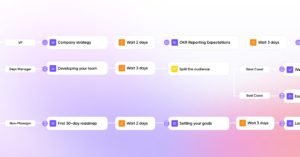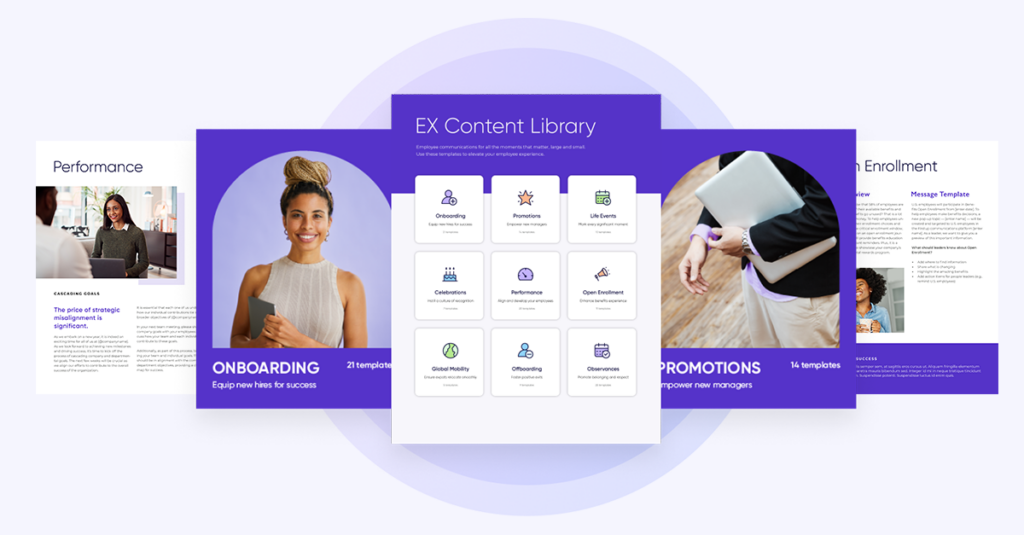Internal communications may not be the first thing you think of but it actually has a big role in impacting a major metric at your company: turnover.
Turnover rates have big implications for any company; and those rates are largely dictated by how happy employees are at work. Because HR and communicators are obsessed with creating a positive employee experience by boosting employee engagement, they can be a critical component of keeping turnover rates low. And that should make all your employees happy (especially your executive team).
Let’s explore the issue of employee turnover and why it’s a critical aspect of any company’s profitability.
What is high employee turnover?
Employee turnover is the rate or number of workers who leave a company and are replaced by new employees. Turnover happens in one of two ways. One, turnover can be voluntary, meaning employees quit their jobs or resign from them. Two, turnover can be involuntary, meaning employees are fired.
Why executives pay attention to turnover
As a metric, turnover is a key component of a company’s overall profitability. Think about how much money it costs to recruit, hire, and train new employees—not to mention the amount of time it takes before employees learn the ropes and can start fully contributing to the company’s bottom line. If employee turnover is high, that means employers have to spend more time and resources finding new workers and training them. On the other hand, if turnover is low, companies won’t have to work so hard to continually find new employees; instead, they’ll benefit from having tenured employees who are familiar with the company processes and culture.

Employee turnover rate statistics
How can you tell if your turnover is high? Typically, high turnover means 28% of your new employees quit within the first 90 days of their employment. (Again: this presents an enormous cost to companies because they have to constantly repeat a cycle of recruitment, hiring, and training new people.) High turnover is often the result of negative employee experiences. Of the 28% of new hires that quit, 34% report that an incident or bad experience drove them away.
What causes high employee turnover?
Obviously, employees who are unhappy at work are more likely to leave and seek a different employer. This means there’s a strong link between high turnover and a lack of employee engagement. Why?
- If workers are bored, disengaged from the company, and don’t care much about their work, they may be motivated to leave.
- Employees may also choose to leave if they are presented with a better compensation or perks package.
- Job perks, including the ability to work from home or unlimited paid time off, may entice workers to switch organizations.
If you want to get a picture of what high turnover looks like in industry, check out companies in healthcare and retail spaces. Traditionally, these professions have higher turnover because employees get bored with mundane, repetitive tasks; so they end up seeking jobs elsewhere. As the gig economy continues to grow, distributed or remote workers may feel less connected to a company and its goals.
Since these workers are all competing for minimum wage jobs, any organization that offers perks that are enticing may get rewarded with more loyal employees. Whether it be a discount on company clothes or a free meal every shift, different workers will seek out jobs based on what benefits appeal to them.
The tech industry also faces one of the highest turnover rates as companies compete for a limited supply of highly skilled workers. Although due to the high demand for technically skilled workers, these individuals typically switch from one good job to another great job.
Turnover and frontline staff
Why is there a high turnover for frontline staff in particular? Chalk it up to a lack of good communication.
Communication at any company is meant to engage two groups: customers, and employees (which can include partners, part-time workers, and freelancers). If internal communications are suffering, then employees may be more likely to seek out organizations that are better at communicating policies, priorities, and procedures with employees.
Employees may also look for companies that have mastered communication best practices for the digital era. These may include:
- Sending employees messages on the communications channel or device they prefer
- Communicating with employees at times that are convenient for them to receive messages
- Encouraging and inviting two-way communication between executives and ground-level employees
- Authentic, transparent communication from executives and CEOs
- Reaching and engaging with deskless and remote workers
How to reduce turnover
Creating a positive employee experience can help decrease the amount of turnover by making people want to stay. If workers are presented with an engaging, supportive, and communicative organization they are more likely to want to continue with a company.
At the end of the day, building a positive employee experience is the key to reducing turnover. There are two key ways to build a positive employee experience in any company.
#1: Communicate with employees regularly.
Having great internal communications can help keep employees engaged and lower your turnover rate. Workers are more likely to stay at an organization if they feel connected to their culture and supported by its staff. Here are some key ways you can improve your internal communications.
- Evaluate your current communications channels. What’s working and what isn’t? Standalone internal communications tools don’t work as well as integrated workforce communications platforms. So your email and intranet alone will not reach your workers over time in the same way as a system that integrates all your channels.
- Improve employee engagement by studying your employees. Learn who they are and what communications channels they prefer. By taking this first step in understanding your audience, you’ll be able to reach and meet your employees’ expectations.
- Create a multi-channel approach in reaching your employees. This allows you the flexibility to reach workers on their preferred channel, and you’ll engage deskless and frontline employees (who may not have easy access to email or the intranet) that prefer a mobile app for your company.
- Measure internal communications content performance. If necessary, start small. Consider what KPIs and metrics are important to understand what success looks like. Track this data over time, and then share it with your team and leaders.
#2: Increase opportunities for managers to give recognition and praise to employees.
Managers often shape workers’ experience at an enterprise, and a lack of support from managers may cause employees to feel like they’re unimportant to the company. In addition, if workers are remote or distributed, it may be difficult for managers to reach them. If managers don’t support their staff, employees may seek companies that have more supportive work cultures.
Managers have tremendous potential to create a positive employee experience. Employees who receive consistent recognition of their good work by their managers are five times more likely to stay at the company, while those who receive consistent help in managing their workload from their managers are eight times more likely to stay. However, only approximately half of the managers effectively accomplish either.
Employees also value hearing from their managers. Companies that implement regular employee feedback have 14.9% lower turnover rates than for employees who receive no feedback. It should also be no surprise that managers even have an effect on how engaged their employees are. Trust is a foundation of engagement: Employees who trust their team leader are 12 times more likely to be fully engaged in their work.
Learn the 5 steps you can take at your organization to increase engagement and improve communication satisfaction, regardless of the location of your employees.
The benefits of increasing employee engagement
Here’s what we know about how profitability ties to the employee experience and employee engagement.
- Workers whose employee experience index scores are in the top quartile are more likely to report high work performance levels than those with scores in the bottom quartile (23 percentage points higher).
- Teams that are engaged and aligned with an organization are more likely to stay. Highly engaged employees are 87% less likely to leave their companies than their less engaged counterparts.
- The benefits of engagement extend beyond turnover, as companies with engaged employees outperform those without by 202%. This impacts financial goals as companies with engaged employees pull in 2.5x more revenues compared to competitors with low engagement levels.
The bottom line is, increasing employee engagement can ensure that workers are interested in their jobs and play a key role in contributing to organizational success.
Cost of employee turnover
Having a high turnover rate is incredibly costly. We know that engagement plays a large role in determining turnover. Only 36% of employees in the United States are actively engaged, according to Gallup. If enterprises want to decrease the amount of turnover, they will need to work on keeping their workforce engaged.
Actively disengaged employees cost the U.S. between $450 billion to $550 billion per year, in part because they are not as productive as their engaged counterparts and have “checked out” of the job.
The effect of disengaged employees extends beyond your bottom line. Unhappy workers are more likely to share negative experiences and affect your brand. Employees are your greatest brand ambassadors, but if they are sharing experiences that are neutral or not positive it could affect your reputation. In turn, that could affect your recruiting efforts and brand perception.
Conclusion
High employee turnover is costly and can negatively affect your business. High turnover is caused by a lack of communication, support, and company culture. Ensuring that your staff has an amazing experience with your organization can help decrease turnover and increase engagement.
Effective internal communication can help increase engagement and ensure that your distributed workforce feel connected to your company. Here are a couple of ways to establish amazing internal communication:
- Integrate your channels with a workforce platform
- Study your employees and discover the best ways to engage them
- Develop a multichannel approach to reach every worker
- Measure the impact of your communications and track your success
Download PDF









